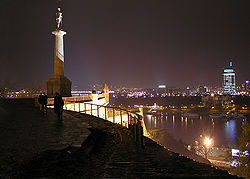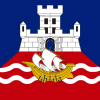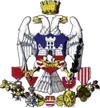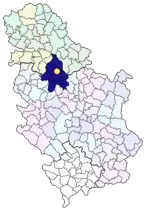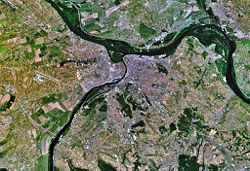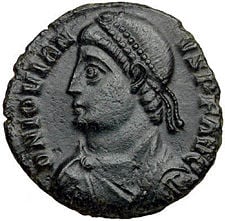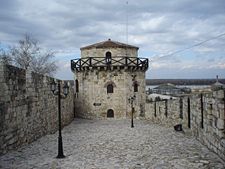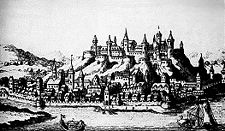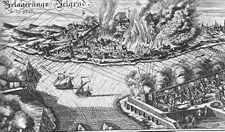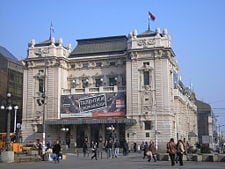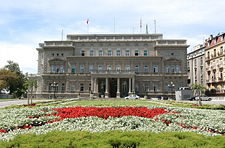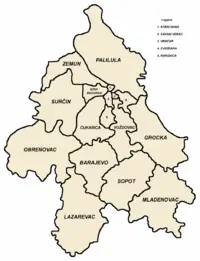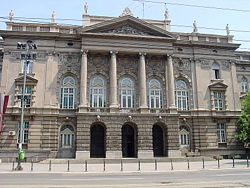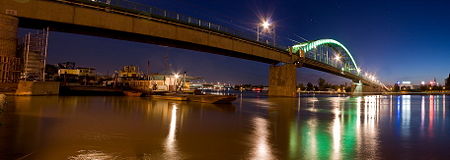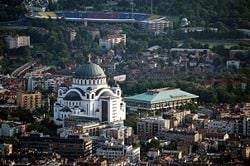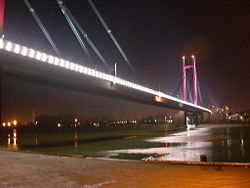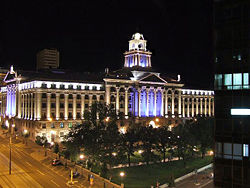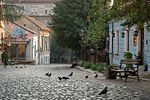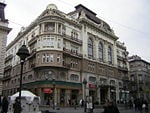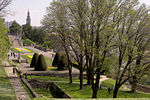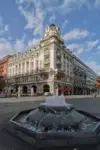Difference between revisions of "Belgrade" - New World Encyclopedia
Mike Butler (talk | contribs) |
Rosie Tanabe (talk | contribs) |
||
| (57 intermediate revisions by 6 users not shown) | |||
| Line 1: | Line 1: | ||
| + | {{Images OK}}{{Submitted}}{{Approved}}{{Copyedited}} | ||
<!-- Infobox begins —> | <!-- Infobox begins —> | ||
{{Infobox Settlement | {{Infobox Settlement | ||
| − | | | + | |official_name = Belgrade |
| − | + | |native_name = Београд | |
| − | | | ||
|other_name = Beograd | |other_name = Beograd | ||
| − | | | + | |settlement_type = City |
| − | + | |image_skyline = NoviBG Nov30 2005.jpg | |
| − | + | |nickname = | |
| − | |image_skyline = | + | |imagesize = 250px |
| − | |imagesize = | + | |image_caption = [[Pobednik]] monument in [[Belgrade fortress|Kalemegdan]], overlooking the skyline of [[Novi Beograd]] |
| − | |image_caption = | ||
|image_flag = Flag of Belgrade.svg | |image_flag = Flag of Belgrade.svg | ||
|flag_size = | |flag_size = | ||
| − | |image_seal = | + | |image_seal = |
|image_shield = Coat of Arms Belgrade.png | |image_shield = Coat of Arms Belgrade.png | ||
| − | |shield_size = | + | |shield_size = |
|image_map = Serbia_Belgrade.png | |image_map = Serbia_Belgrade.png | ||
| − | |mapsize = | + | |mapsize = 150px |
|map_caption = Location of Belgrade within Serbia | |map_caption = Location of Belgrade within Serbia | ||
| − | |subdivision_type = | + | |coordinates_region = RS |
| + | |subdivision_type = Country | ||
|subdivision_name = {{flag|Serbia}} | |subdivision_name = {{flag|Serbia}} | ||
|subdivision_type1 = [[Districts of Serbia|District]] | |subdivision_type1 = [[Districts of Serbia|District]] | ||
| Line 25: | Line 25: | ||
|subdivision_type2 = [[Municipalities of Serbia|Municipalities]] | |subdivision_type2 = [[Municipalities of Serbia|Municipalities]] | ||
|subdivision_name2 = [[#Municipalities|17]] | |subdivision_name2 = [[#Municipalities|17]] | ||
| − | |government_type = | + | |government_type = |
|leader_title = [[Mayor of Belgrade|Mayor]] | |leader_title = [[Mayor of Belgrade|Mayor]] | ||
| − | |leader_name = [[ | + | |leader_name = [[Dragan Đilas]] ([[Democratic Party (Serbia)|DS]]) |
| − | |leader_title1 = [[List of political parties in Serbia|Ruling parties]] | + | |leader_title1 = [[List of political parties in Serbia|Ruling parties]] |
| − | |leader_name1 = [[Democratic Party (Serbia)|DS]]/[[G17+]]/[[Socialist Party of Serbia|SPS]]/[[Liberal Democratic Party (Serbia 2005)|LDP]] | + | |leader_name1 = [[Democratic Party (Serbia)|DS]]/[[G17+]]/[[Socialist Party of Serbia|SPS]]-[[Party of United Pensioners of Serbia|PUPS]]/[[Liberal Democratic Party (Serbia 2005)|LDP]] |
| − | + | |established_title = Establishment | |
| − | + | |established_date = before 279 B.C.E. ([[Singidunum]])<ref>{{cite web|url=http://www.beograd.rs/cms/view.php?id=201172|title=Ancient Period|publisher=City of Belgrade|date=|accessdate=March 16, 2012}}</ref> | |
| − | + | |area_footnotes = <ref>{{cite web|url=http://www.beograd.rs/cms/view.php?id=201197|title=Territory|publisher=City of Belgrade|accessdate=March 16, 2012}}</ref> | |
| − | + | |area_magnitude = | |
| − | |established_title = | + | |area_total_km2 = |
| − | |established_date = | + | |area_total_sq_mi = |
| − | | | + | |area_land_km2 = |
| − | | | + | |area_land_sq_mi = |
| − | | | ||
| − | | | ||
| − | | | ||
| − | |area_magnitude = | ||
| − | |area_total_km2 = | ||
| − | |area_total_sq_mi = | ||
| − | |area_land_km2 = | ||
| − | |area_land_sq_mi = | ||
|area_water_km2 = | |area_water_km2 = | ||
| − | |area_water_sq_mi = | + | |area_water_sq_mi = |
| − | |area_water_percent = | + | |area_water_percent = |
| − | | | + | |area_total_km2 = 359.96 |
| − | | | + | |area_urban_km2 = 869 |
| − | |area_metro_km2 = | + | |area_metro_km2 = 3222.68 |
| − | |area_metro_sq_mi = | + | |area_metro_sq_mi = |
| − | |area_blank1_title = | + | |area_blank1_title = |
| − | |area_blank1_sq_mi = | + | |area_blank1_sq_mi = |
| − | |area_blank1_km2 = | + | |area_blank1_km2 = |
| − | |area_blank2_title = | + | |area_blank2_title = |
| − | |area_blank2_sq_mi = | + | |area_blank2_sq_mi = |
| − | |area_blank2_km2 = | + | |area_blank2_km2 = |
| − | |population_as_of = | + | |population_as_of = 2011 |
| − | |population_footnotes = | + | |population_footnotes = <ref>{{citation|url=http://webrzs.stat.gov.rs/WebSite/repository/documents/00/00/49/86/Prvi_rezultati_Konferencija.pps |title=PRVI REZULTATI, Konferencija za novinare |publisher=Statistical Office of the Republic of Serbia |language=Serbian |date=2011-11-15 |page=11}} Retrieved March 16, 2012.</ref> |
| − | <ref | + | |population_note = |
| − | + | |population_total = {{increase}} 1154589 | |
| − | + | |population_density_km2 = 3207.5 | |
| − | + | |population_density_sq_mi = | |
| − | + | |population_metro = {{increase}}1,639,121 | |
| − | + | |population_density_metro_km2 = 508.6 | |
| − | + | |population_density_metro_sq_mi = | |
| − | + | |population_demonym = Belgrader | |
| − | |publisher=Statistical Office of the Republic of Serbia | ||
| − | |||
| − | |||
| − | |||
| − | }}</ref> | ||
| − | |population_note | ||
| − | |population_total | ||
| − | |population_density_km2 = | ||
| − | |population_density_sq_mi = | ||
| − | | | ||
| − | |population_density_metro_km2 = | ||
| − | |population_density_metro_sq_mi = | ||
| − | | | ||
| − | |||
| − | |||
| − | |||
| − | |||
|population_density_blank1_km2 = | |population_density_blank1_km2 = | ||
|population_density_blank1_sq_mi = | |population_density_blank1_sq_mi = | ||
| Line 92: | Line 67: | ||
|population_density_blank2_km2 = | |population_density_blank2_km2 = | ||
|population_density_blank2_sq_mi = | |population_density_blank2_sq_mi = | ||
| − | |timezone | + | |timezone = [[Central European Time|CET]] |
| − | |utc_offset | + | |utc_offset = +1 |
| − | |timezone_DST | + | |timezone_DST = [[Central European Summer Time|CEST]] |
| − | |utc_offset_DST | + | |utc_offset_DST = +2 |
| − | |latd = 44|latm= 49|lats =14|latNS = N | + | |latd = 44|latm= 49|lats =14|latNS = N |
| − | |longd = 20|longm = 27|longs =44|longEW = E | + | |longd = 20|longm = 27|longs =44|longEW = E|coordinates_display=3 |
| − | |elevation_footnotes | + | |elevation_footnotes = |
| − | <ref>{{cite web|url=http://www.beograd.rs/cms/view.php?id=201029|title=Geographical | + | <ref>{{cite web|url=http://www.beograd.rs/cms/view.php?id=201029|title=Geographical position|publisher=City of Belgrade|accessdate=March 16, 2012}}</ref> |
| − | |elevation_m | + | |elevation_m = 117 |
| − | |elevation_ft | + | |elevation_ft = 384 |
| − | |postal_code_type | + | |postal_code_type = Postal code |
| − | |postal_code | + | |postal_code = 11000 |
| − | |area_code | + | |area_code = (+381) 11 |
| − | |website | + | |website = [http://www.beograd.rs/ www.beograd.rs] |
| − | |blank_name | + | |blank_name = [[Vehicle registration plates of Serbia|Car plates]] |
| − | |blank_info | + | |blank_info = BG |
}} <!-- Infobox ends —> | }} <!-- Infobox ends —> | ||
| − | '''Belgrade''' | + | |
| + | '''Belgrade''' is the [[capital]] and largest city of [[Serbia]]. The city lies at the confluence of the [[Sava River|Sava]] and [[Danube]] Rivers in north central Serbia, where the [[Pannonian Plain]] meets the [[Balkan Peninsula]]. With a population of over 1.9 million (estimate 2008), Belgrade is the largest city in the territory of the former [[Yugoslavia]] and the fourth largest in [[Southeastern Europe]], after [[Istanbul]], [[Athens]], and [[Bucharest]]. | ||
| + | |||
| + | One of [[Europe]]'s oldest cities, with a history of 7000 years, Belgrade's wider city area was the birthplace of the largest [[prehistory|prehistoric]] culture of Europe, the [[Vinča culture]]. The foundation of the city itself dates back to [[Celts|Celtic]] and later, [[Roman Empire|Roman]] periods, followed by the settlement of [[Slavs]] around the seventh century. Since ancient times it has been an important focal point for commercial traffic, an intersection of the roads of Eastern and Western Europe. Today it is the central economic hub of Serbia, and the capital of culture, education and science. | ||
| + | {{toc}} | ||
| + | The city suffered from corruption and abuse of power during the [[Slobodan Milošević|Miloševic]]-era, including mismanagement of the economy, as well as from years of economic sanctions, [[war]]s and damage to the [[infrastructure]]. A focus of the city's, and the nation's, leaders has been stabilization of the economic and social services systems. The government has committed itself to pursue socially accountable policy in an attempt to avoid social stratification of the population which has occurred in some former [[socialism|socialist]] countries during their periods of transition. | ||
==Geography== | ==Geography== | ||
[[Image:Beograd Sat.jpg|250px|thumb|left|Satellite view of Belgrade.]] | [[Image:Beograd Sat.jpg|250px|thumb|left|Satellite view of Belgrade.]] | ||
| − | Belgrade lies at the confluence of the [[Sava River|Sava]] and [[Danube]] rivers in north central Serbia, where the [[Pannonian Plain]] meets the [[Balkan Peninsula]]. There, three trade routes - one from [[Vienna]] to the [[Black Sea]] along the Danube River valley, another along the Sava River valley toward [[Trieste]], and a third along the Morava and Vardar rivers to the [[Aegean Sea]]. | + | Belgrade lies at the confluence of the [[Sava River|Sava]] and [[Danube]] rivers in north central [[Serbia]], where the [[Pannonian Plain]] meets the [[Balkan Peninsula]]. There, three trade routes exist - one from [[Vienna]] to the [[Black Sea]] along the Danube River valley, another along the Sava River valley toward [[Trieste]], and a third along the Morava and Vardar rivers to the [[Aegean Sea]]. |
| − | On the right bank of the Sava, central Belgrade has hilly terrain, while the highest point of Belgrade proper is [[Torlak (Belgrade)|Torlak hill]] at 994 feet (303 meters). The | + | On the right bank of the Sava, central Belgrade has hilly terrain, while the highest point of Belgrade proper is [[Torlak (Belgrade)|Torlak hill]] at 994 feet (303 meters). The [[mountain]]s of [[Avala]], at 1677 feet (511 meters), and [[Kosmaj]], 2060 feet (628 meters) lie south of the city. Across the Sava and Danube, the land is mostly flat, consisting of [[alluvial plain]]s and [[loam|loessial]] [[plateau]]s. |
| − | Belgrade has a moderate [[continental climate]]. The hottest month is July, with an average temperature of 71.8°F (22.1°C), and the January temperature averages 34°F (1°C). Belgrade receives 27.56 inches (700mm) of precipitation a year. | + | The Danube flows through over 37 miles (60 km) of the area, while the Sava covers nearly 19 miles (30 km). The city's riverbanks cover 124 miles (200 km). There are 16 river islands in the area, the best known being Ada Ciganlija, Veliko ratno ostrvo and Gročanska ada. Belgrade also has many wooded areas, such as Kosmaj, Avala, Trešnja, Lipovica, Topčider, Obrenovački zabran and Bojčin. |
| + | |||
| + | Belgrade has a moderate [[continental climate]]. The hottest month is July, with an average [[temperature]] of 71.8°F (22.1°C), and the January temperature averages 34°F (1°C). Belgrade receives 27.56 inches (700mm) of precipitation a year. | ||
| − | The historical core of Belgrade (today's | + | The historical core of Belgrade (today's Kalemegdan) is on the right bank of the rivers. Since the nineteenth century, the city has expanded south and east, and after [[World War II]], New Belgrade was built on the Sava's left bank, merging Belgrade with [[Zemun]]. Smaller residential communities across the Danube, such as [[Krnjača]] and [[Ovča]], also merged with the city. |
| − | The city has an urban area of 139 square miles (360 square kilometers), while its metropolitan area covers 1244.4 square miles (3223 square kilometers). | + | The city has an urban area of 139 square miles (360 square kilometers), while its metropolitan area covers 1244.4 square miles (3223 square kilometers). |
==History== | ==History== | ||
| − | [[Image:Jovian1.jpg|thumb|right| | + | [[Image:Jovian1.jpg|thumb|right|225px|[[Jovian|Flavius Iovanus]], [[Roman Emperor]] from [[Singidunum]]]] |
| − | [[Image:Siege of | + | [[Image:Siege of Nandorfehervar.jpg|thumb|225px|right|The [[Siege of Belgrade]] in 1456.]] |
| − | [[Image:Kul jak.jpg| | + | [[Image:Kul jak.jpg|225px|thumb|right|Belgrade Fortress - Jakšić's Tower.]] |
| − | [[Image:Fortress Belgrade.jpg| | + | [[Image:Fortress Belgrade.jpg|225px|thumb|right|Belgrade in the sixteenth century]] |
| − | [[Image:Belagerung belgrad 1717.jpg|thumb|right| | + | [[Image:Belagerung belgrad 1717.jpg|thumb|right|225px|Austrian conquest of Belgrade: 1717 by [[Eugene of Savoy]], during the [[Austro-Turkish War of 1716-1718]]]] |
| − | [[Image:Knez stara.jpg|thumb|right| | + | [[Image:Knez stara.jpg|thumb|right|225px|Knez Mihailova street at the beginning of the twentieth century]] |
| − | + | [[Image:Beograd - National Theater 02.jpg|thumb|right|225px|[[National Theatre in Belgrade]]]] | |
| − | [[Image:Beograd - National Theater 02.jpg|thumb|right| | + | [[Image:Belgrade Old Court 1.jpg|thumb|225px|The Old Palace, seat of the Assembly of the City of Belgrade.]] |
| − | [[Image:Belgrade | + | The [[Neolithic]] [[Starčevo-Körös|Starčevo]] and [[Vinča culture]]s existed in or near Belgrade about 7000 years ago. Settled in the fourth century B.C.E. by a [[Celt]]ic tribe, the [[Scordisci]], the city's first recorded name was Singidūn, before becoming the [[Roman Empire|Roman]] settlement of [[Singidunum]] in the first century C.E. Roman Emperor [[Jovian]] (331-364), who re-established [[Christianity]] as the official religion of the Roman Empire, was born in Singidunum. In 395, the site passed to the Eastern Roman or [[Byzantine Empire]]. Across the Sava from Singidunum was the Celtic city of [[Zemun|Taurunum (Zemun)]]. |
| − | The [[Neolithic]] [[Starčevo-Körös|Starčevo]] and [[Vinča culture]]s existed in or near Belgrade about 7000 years ago. Settled in the fourth century | ||
===Slavs arrive=== | ===Slavs arrive=== | ||
| − | Singidunum was invaded by [[Huns]], [[Sarmatians]], [[Ostrogoths]] and [[Eurasian Avars|Avars]] before the arrival of the [[Slavic peoples|Slav]]s around 630. The [[Frankish Kingdom]] | + | Singidunum was invaded by [[Huns]], [[Sarmatians]], [[Ostrogoths]] and [[Eurasian Avars|Avars]] before the arrival of the [[Slavic peoples|Slav]]s around 630. The [[Frankish Kingdom]] destroyed the [[Avars]] in the ninth century. The [[Slavic languages|Slavic]] name ''Beligrad'' appeared around 878, during the rule of the [[First Bulgarian Empire]]. The city remained a battleground between the [[Byzantine Empire]], the [[Kingdom of Hungary]], and the First Bulgarian Empire for about 400 years. The city hosted the armies of the [[First Crusade|First]] (launched 1096) and the [[Second Crusade]]s (1147–1149). While passing through during the [[Third Crusade]] (1189–1192), [[Frederick Barbarossa]] saw Belgrade in ruins. Capital of the [[Kingdom of Syrmia]] since 1284, the first Serbian king to rule over Belgrade was [[Stefan Dragutin|Dragutin]] (died 1316), who received it as a gift from his father-in-law, the Hungarian king [[Stephen V of Hungary|Stephen V]]. |
===Belgrade a haven=== | ===Belgrade a haven=== | ||
| − | The [[Serbian Empire]] began to crumble after the [[Battle of Maritsa]] (1371), and the [[Battle of Kosovo]] (1389), as the [[Ottoman Empire]] conquered its southern territory. | + | The [[Serbian Empire]] began to crumble after the [[Battle of Maritsa]] (1371), and the [[Battle of Kosovo]] (1389), as the [[Ottoman Empire]] conquered its southern territory. Belgrade flourished under [[Despotism|despot]] [[Stefan Lazarević]] (1374-1427), who refortified the city's ancient walls, allowing the Despotate to resist the Ottomans for almost 70 years. The city became a haven for the many Balkan peoples fleeing from Ottoman rule, and is thought to have had a population of some 40,000–50,000. |
| − | In 1427, Stefan's successor [[Đurađ Branković]] had to return Belgrade to the [[Kingdom of Hungary|Hungarians]], and the Serbian capital was moved to [[Smederevo fortress|Smederevo]]. During his reign, the Ottomans captured most of the [[Serbian Despotate]], unsuccessfully besieging Belgrade first in 1440 and again in 1456. Over 100,000 Ottoman | + | In 1427, Stefan's successor [[Đurađ Branković]] had to return Belgrade to the [[Kingdom of Hungary|Hungarians]], and the Serbian capital was moved to [[Smederevo fortress|Smederevo]]. During his reign, the Ottomans captured most of the [[Serbian Despotate]], unsuccessfully besieging Belgrade first in 1440 and again in 1456. Over 100,000 Ottoman soldiers launched the famous [[Siege of Belgrade]] (July 4 to July 22, 1456), where the [[Christian]] army under [[John Hunyadi]] successfully defended the city, wounding the Sultan [[Mehmed II]]. This battle was regarded as "deciding the fate of Christendom." |
===Turkish conquest=== | ===Turkish conquest=== | ||
| − | Sultan [[Suleyman the Magnificent]] (1494-1566) and his 250,000 soldiers captured the fort | + | Sultan [[Suleyman the Magnificent]] (1494-1566) and his 250,000 soldiers captured the fort on August 28, 1521, razed most of the city, and deported its Christian population to [[Istanbul]]. Belgrade was made an Ottoman [[Sanjak]], attracting new inhabitants—[[Turkic peoples|Turks]], [[Armenia]]ns, [[Greece|Greeks]], [[Republic of Ragusa|Ragusan]] traders, and others – becoming the second largest [[Ottoman Turks|Ottoman]] town in [[Europe]] with over 100,000 people. Turkish rule introduced Ottoman [[architecture]] and built many [[mosque]]s. |
| − | In 1594, the Turks crushed a | + | In 1594, the Turks crushed a Serb rebellion. [[Albania]]n- born [[Grand vizier]] [[Sinan Pasha]] (1506-1596) is disdained by the Serbs for ordering, in 1595, that the relics of [[Saint Sava]], the founder of the independent [[Serbian Orthodox Church]] in the twelfth century, be burned as a revenge for Serbs siding with the [[Habsburg]]s in the preceding border skirmishes. Further deportations to [[Istanbul]] followed. |
===Austrian occupation=== | ===Austrian occupation=== | ||
| − | Habsburg Austria occupied Belgrade three times (1688–1690, 1717–1739, 1789–1791), but the Ottomans recaptured and razed the city each time. This was the period of the two [[Great Serbian Migrations]], in which hundreds of thousands of Serbs, led by their | + | Habsburg Austria occupied Belgrade three times (1688–1690, 1717–1739, 1789–1791), but the [[Ottoman Empire|Ottomans]] recaptured and razed the city each time. This was the period of the two [[Great Serbian Migrations]], in which hundreds of thousands of Serbs, led by their patriarchs, retreated together with the Austrians into the Habsburg Empire, settling in today's [[Vojvodina]] and [[Slavonia]]. |
===Serbian uprisings=== | ===Serbian uprisings=== | ||
| − | During the [[First Serbian Uprising]], the Serbian revolutionaries held the city from January 8, 1806, until 1813, when the Ottomans retook the city. After the [[Second Serbian Uprising]] in 1817, Serbia reached semi-independence, which the Ottoman | + | During the [[First Serbian Uprising]], the Serbian revolutionaries held the city from January 8, 1806, until 1813, when the Ottomans retook the city. After the [[Second Serbian Uprising]] in 1817, Serbia reached semi-independence, which the Ottoman Porte recognized in 1830. When Serbia reached full independence in 1878, and became the [[Kingdom of Serbia]] in 1882, Belgrade became a key [[city]], but Serbia remained overwhelmingly agrarian and poor. In 1900, the capital had only 69,100 inhabitants, by 1905 the population had grown to more than 80,000, and by the outbreak of [[World War I]] in 1914, it had surpassed the 100,000 citizens. |
| − | |||
| − | When Serbia reached full independence in 1878, and became the [[Kingdom of Serbia]] in 1882, Belgrade became a key city, but Serbia remained overwhelmingly agrarian and poor. In 1900, the capital had only 69,100 inhabitants, by 1905 the population had grown to more than 80,000, and by the outbreak of [[World War I]] in 1914, it had surpassed the 100,000 citizens. | ||
===World War I=== | ===World War I=== | ||
| − | [[Gavrilo Princip]]'s [[assassination of Archduke Franz Ferdinand]] of Austria and his wife Sophie, Duchess of Hohenberg, in [[Sarajevo]] on June 28, 1914, triggered [[World War I]]. The [[Austro-Hungarian Army]] took Belgrade on November 30, 1914, but Serbian troops took the city on December 15. Belgrade fell to | + | [[Gavrilo Princip]]'s [[assassination]] of Archduke [[Franz Ferdinand]] of Austria and his wife Sophie, Duchess of Hohenberg, in [[Sarajevo]] on June 28, 1914, triggered [[World War I]]. The [[Austro-Hungarian Army]] took Belgrade on November 30, 1914, but Serbian troops took the city on December 15. Belgrade fell to German and Austro-Hungarian troops on October 9, 1915. The city was liberated by Serbian and French troops on November 5, 1918. |
| − | After the war, Belgrade became the capital of the new Kingdom of Serbs, Croats and Slovenes, renamed the [[Kingdom of Yugoslavia]] in 1929. The kingdom was split into ''banovinas'' | + | After the war, Belgrade became the capital of the new Kingdom of Serbs, Croats and Slovenes, renamed the [[Yugoslavia|Kingdom of Yugoslavia]] in 1929. The kingdom was split into ''banovinas,'' and Belgrade, together with [[Zemun]] and [[Pančevo]], formed a separate administrative unit. Belgrade's population grew to 239,000 by 1931 (incorporating the town of Zemun, formerly in Austria-Hungary), and 320,000 by 1940. In 1927, Belgrade's first [[airport]] opened, and in 1929, its first [[radio]] station began broadcasting. The [[Pančevo Bridge]] across the [[Danube]] was opened in 1935. |
| − | |||
| − | Belgrade's population grew to 239,000 by 1931 (incorporating the town of | ||
===World War II=== | ===World War II=== | ||
| − | On March 25, 1941, the government of | + | On March 25, 1941, the government of regent Crown Prince Paul signed the [[Tripartite Pact]] with the [[Axis powers]] to avoid [[war]]. This sparked mass protests in Belgrade and a military [[coup d'état]] led by Air Force commander General [[Dušan Simović]], who proclaimed King Peter II to be of age to rule the realm. The German [[Luftwaffe]] bombed the city on April 6, 1941, and up to 17,000 citizens were killed. German, Italian, Hungarian, and Bulgarian forces invaded [[Yugoslavia]]. Belgrade's eastern suburbs were incorporated into a Nazi [[puppet state]], the [[Independent State of Croatia]], while Belgrade became the seat of another puppet government, headed by General [[Milan Nedić]]. |
| − | During the summer and fall of 1941, in reprisal for guerrilla attacks, Germans carried out several massacres of Belgrade citizens; in particular, members of the [[ | + | During the summer and fall of 1941, in reprisal for [[guerrilla war|guerrilla]] attacks, Germans carried out several massacres of Belgrade citizens; in particular, members of the [[Jewish]] community were subject to mass shootings. General [[Franz Böhme]], the German Military Governor of Serbia, rigorously enforced the rule that for every German killed, 100 Serbs or Jews would be shot. |
| − | Belgrade | + | The Allies bombed Belgrade on April 16, 1944, killing 1600 people. Communist Yugoslav Partisans and the [[Red Army]] liberated the city on October 20, 1944. On November 29, 1945, Marshal [[Josip Broz Tito]] proclaimed the [[Federal People's Republic of Yugoslavia]] in Belgrade (later to be renamed to [[Socialist Federal Republic of Yugoslavia]] on April 7, 1963). |
===Belgrade grows=== | ===Belgrade grows=== | ||
| − | During the post-war period, Belgrade | + | During the post-war period, Belgrade developed as an [[industrialization|industrial]] center. The city's first [[television]] station began [[broadcasting]] in 1958. In 1961, the conference of [[Non-Aligned Countries]] was held in Belgrade under [[Tito]]'s chairmanship. In 1968, student protests against Tito led to street clashes between students and the police. In March 1972, Belgrade was at the center of the last outbreak of [[smallpox]] in Europe. |
===After communism=== | ===After communism=== | ||
| − | On March 9, 1991, | + | On March 9, 1991, [[Vuk Drašković]] led 150,000 people in protest against Serbian president [[Slobodan Milošević]] (1941-2006). Two people were killed, 203 injured and 108 arrested. Tanks were deployed to restore order. Further protests were held from November 1996 to February 1997 after alleged electoral fraud at local elections, bringing [[Zoran Đinđić]] to power, the first non-[[communism|communist]] [[mayor of Belgrade]] since [[World War II]]. [[NATO]] bombing during the [[Kosovo War]] in 1999 caused substantial damage to Belgrade. After the elections in 2000, street protests by over 800,000 people resulted in the ousting of Milošević, on October 5, 2000. |
| − | + | ==Government== | |
| − | |||
| − | |||
| − | + | [[Image:Belgrade municipalities03.png|thumb|left|200px|Map of the municipalities of Belgrade.]] | |
| − | [[Image:Belgrade | + | [[Serbia]] is a parliamentary representative democratic republic. The chief of state is the president, elected for a five-year term, and the prime minister is the head of government, and of a multi-party system. The unicameral Serbian national assembly, which has 250 members, elects the prime minister. The part of Serbia that is neither in Kosovo nor in Vojvodina, often called "Serbia proper," is divided into 29 districts plus the City of Belgrade. |
| − | [[ | ||
| − | |||
| − | As a separate territorial unit, Belgrade has an autonomous city government. The Civic Assembly of Belgrade has 110 | + | As a separate territorial unit, Belgrade has an autonomous city government. The Civic Assembly of Belgrade has 110 councilors who are elected for four-year terms. The 2008 majority parties are the same as in the [[Parliament of Serbia]]. The city is divided into 17 municipalities, 10 with "urban" status, and seven with "suburban" status. While each has its own local council, the suburban municipalities have slightly expanded powers, regarding construction, town planning and public utilities. |
| − | Most | + | Most municipalities are on the southern side of the [[Danube]] and [[Sava]] rivers, in the [[Šumadija]] region. [[Zemun]], [[Novi Beograd]], and [[Surčin]] are on the northern bank of the Sava, and [[Palilula (Belgrade)|Palilula]], spanning the Danube, is in both the Šumadija and [[Banat]] regions. |
==Economy== | ==Economy== | ||
| − | [[Image: | + | [[Image:Faculty of Architecture and Civil Engineering, Belgrade, Serbia.jpg|250px|thumb|right|Faculty of Electrical Engineering, Architecture and Civil Engineering, University of Belgrade.]] |
| − | |||
| − | |||
| − | |||
| − | By 2008, over 30 percent of Serbia's [[GDP]] was generated by the city, which also has over 30 percent of Serbia's employed population. In terms of GDP per capita, Belgrade holds the region's top position, with | + | Belgrade is the most economically developed part of [[Serbia]]. The rocky transition from the former [[Yugoslavia]] to the Federal Republic during the early 1990s left Belgrade, like the rest of the country, harmed by an international [[trade embargo]] and [[hyperinflation]]. Yugoslavia overcame the problems of inflation in the mid-1990s. By 2008, over 30 percent of Serbia's [[GDP]] was generated by the city, which also has over 30 percent of Serbia's employed population. In terms of GDP per capita, Belgrade holds the region's top position, with a figure of $US18,204 in terms of purchasing power parity. |
| − | Many notable companies are based in Belgrade, including [[Jat Airways]], [[Telekom Srbija]], [[Telenor Serbia]], [[Delta Holding]], regional centers for [[Société Générale]], [[Intel]],[[Motorola]], [[Kraft Foods]], | + | Many notable companies are based in Belgrade, including [[Jat Airways]], [[Telekom Srbija]], [[Telenor Serbia]], [[Delta Holding]], regional centers for [[Société Générale]], [[Intel]],[[Motorola]], [[Kraft Foods]], [[Carlsberg]], [[Microsoft]], [[Zepter International|Zepter]], [[Japan Tobacco]] and many others. |
| − | Belgrade is a media hub. The city hosts the headquarters of the national broadcaster [[Radio Television of Serbia|Radio Television Serbia - RTS]], the RTS record label is based there, as is commercial broadcaster [[RTV Pink]]. High-circulation daily | + | Belgrade is a media hub. The city hosts the headquarters of the national broadcaster [[Radio Television of Serbia|Radio Television Serbia - RTS]], the RTS record label is based there, as is commercial broadcaster [[RTV Pink]]. High-circulation daily [[newspaper]]s published in Belgrade include ''Politika,'' ''Blic,'' ''Večernje novosti,'' ''Glas javnosti,'' ''Press'' and ''Sportski žurnal.'' |
| − | Belgrade has an extensive public transport system based on [[bus]]es (118 urban lines and more than 300 suburban lines), [[tram]]s (12 lines), and [[trolleybus]]es (eight lines). Belgrade | + | Belgrade has an extensive public transport system based on [[bus]]es (118 urban lines and more than 300 suburban lines), [[tram]]s (12 lines), and [[trolleybus]]es (eight lines). Belgrade has a [[regional rail|commuter rail]] network, [[Beovoz]]. Travel by [[Coach (vehicle)|coach]] is popular. The [[motorway]] system provides for easy access to [[Novi Sad]] and [[Budapest]] in the north; [[Niš]] to the south; and [[Zagreb]], to the west. |
| − | + | Belgrade has numerous [[bridge]]s—the two main ones being [[Branko's bridge]] and [[Gazela]], both of which connect the core of the city to Novi Beograd (New Belgrade). | |
| − | The [[Port of Belgrade]] is on the Danube | + | The [[Port of Belgrade]] is on the Danube. The city is also served by [[Belgrade Nikola Tesla Airport]], 12km west of the city center. At its peak in 1986, nearly three million passengers traveled through the airport, though that number dwindled to a trickle in the 1990s. In 2007, 2.5 million passengers passed through. |
| − | + | Traffic congestion has become a problem. This was expected to be alleviated by the construction of a bypass, an "inner magistral semi-ring," and new bridges across the Sava and Danube rivers. | |
==Demographics== | ==Demographics== | ||
| + | Belgrade had 1,531,741 eligible voters in December 2007, according to the city's Institute for Informatics and Statistics. The number of registered voters nearly exceeded the entire population of the city six years earlier. | ||
| + | |||
| + | Belgrade has attracted people of varied ethnicity, who went there seeking a better life, or who fled as refugees from [[war]] and [[ethnic cleansing]]. The main ethnic groups are [[Serbs]] (1,203,045), [[Montenegrins]] (25,000), [[Romani people|Roma]] (19,000), [[Croats]] (7000), [[Macedonians (ethnic group)|Macedonians]] (8372), and [[Muslims by nationality]] (4617). Belgrade is home to up to 20,000 [[Overseas Chinese|Chinese]], who began moving there in the mid-1990s. Blok 70 in New Belgrade is known locally as the Chinese quarter. | ||
| + | |||
| + | Many Middle Easterners, mainly from [[Syria]], [[Iran]], [[Jordan]] and [[Iraq]], arrived to study during the 1970s and 1980s, and have remained. Afghani and Iraqi Kurdish refugees are among some of the recent arrivals from the [[Middle East]]. | ||
| + | [[Image:Belgrade Sava bridge.jpg|thumb|450px|right|Old [[Sava]] bridge.]] | ||
| + | The [[Serbian language]] is the official [[language]]. Other languages include Romanian, Hungarian, Slovak, Ukrainian, and Croatian. Many are able to communicate in [[English language|English]] as well, though somewhat limitedly. | ||
| + | |||
| + | The [[Serbian Orthodox Church|Serbian Orthodox]] community is by far the largest, with 1,429,170 adherents. There are 20,366 [[Islam|Muslims]], 16,305 [[Roman Catholic Church|Roman Catholics]], and 3796 [[Protestantism|Protestants]]. There was once a significant [[Jewish]] community, but following the Nazi occupation, and many Jews' subsequent emigration to [[Israel]], their numbers have fallen to a mere 515 (2008). | ||
| + | |||
| + | Belgrade has two state [[university|universities]] and several private institutions for higher [[education]]. The "Great School," founded in Belgrade in 1808, was the earliest location of higher education in Serbia. The [[Lyceum]] followed in 1841, when it was moved from [[Kragujevac]]. By 1905, it had evolved into the [[University of Belgrade]], which has more than 70,000 students. | ||
| + | |||
| + | ==Places of Interest== | ||
[[Image:Saint Sava et Partizan stadium.jpg|thumb|right|250px|Temple of Saint Sava and the National Library of Serbia.]] | [[Image:Saint Sava et Partizan stadium.jpg|thumb|right|250px|Temple of Saint Sava and the National Library of Serbia.]] | ||
| − | [[Image: | + | [[Image:New Railway Bridge 1.jpg|thumb|right|250px|New Railroad Bridge.]] |
| − | Belgrade | + | [[Image:Belgrade Rail HQ.JPG|thumb|250px|Railway Museum.]] |
| + | |||
| + | The historic areas and buildings of Belgrade are among the city's premier attractions. Belgrade has wildly varying [[architecture]], from the center of [[Zemun]], typical of a [[Central Europe]]an town, to the more modern architecture and spacious layout of [[Novi Beograd|New Belgrade]]. The oldest buildings date only from nineteenth century, due to frequent wars and destruction. The oldest public structure in Belgrade is a nondescript Turkish [[turbe]], while the oldest house is a modest clay house on [[Dorćol]], from late eighteenth century. Of interest are: | ||
| + | |||
| + | * Skadarlija, located in the municipality of Stari Grad (Old town), and considered the main [[bohemian]] quarter of Belgrade. More traditional Serbian nightlife may be experienced there, accompanied by traditional [[music]] known as ''[[Starogradska]].'' Skadar Street (the center of Skadarlija) and the surrounding neighborhood are lined with some of Belgrade's best and oldest traditional [[restaurant]]s (called ''kafanas'' in Serbian). The neighborhood has Belgrade's oldest [[brewery]], founded in the first half of the nineteenth century. | ||
| + | |||
| + | * The [[National Museum of Serbia|National Museum]], founded in 1844, houses a collection of more than 400,000 exhibits,(over 5600 paintings and 8400 drawings and prints) including many foreign masterpieces and the famous [[Miroslav's Gospel|Miroslavljevo Jevanđelje]] (Miroslav's Gospel). | ||
| + | |||
| + | * The [[Military Museum (Belgrade)|Military Museum]], which houses a wide range of more than 25,000 military exhibits dating as far back as to the [[Roman Empire|Roman period]], as well as parts of a [[F-117]] stealth aircraft shot down by Yugoslav forces. | ||
| + | |||
| + | * [[Zemun]], which is considered by the local population as a separate, and more cultural city than Belgrade. Belgraders consider Zemun an outer, Austro-Hungarian suburb of Belgrade. | ||
| − | + | * [[Nikola Pašić Square]], is one of the central town squares, is named after [[Nikola Pašić]] who served as mayor of Belgrade, prime minister of Serbia and prime minister of Yugoslavia. | |
| − | + | * The [[Kalemegdan|Kalemegdan Fortress]], is the core and the oldest section of the urban area of Belgrade and for centuries the city population was concentrated only within the walls of the fortress. | |
| − | + | * [[Knez Mihailova|Knez Mihailova St]], the favorite strolling avenue of the city. | |
| − | The [[ | + | * The [[Temple of Saint Sava]] is the largest [[Orthodox church (building)|Orthodox church]] in use in Belgrade. |
| − | + | * The [[Yugoslav Film Archive]], with around 95,000 copies of films, is among the 10 largest archives in the world. | |
| − | + | The city was one of the main centers of the [[Yugoslav New Wave]] [[music]] in the 1980s. There are numerous theaters, the most prominent of which are [[National Theatre in Belgrade|National Theatre]], [[Theatre on Terazije]], [[Yugoslav Drama Theatre]], [[Zvezdara Theatre]], and [[Atelje 212|Atelier 212]]. Belgrade's two [[opera]] houses are: National Theatre and [[Zemun|Madlenijanum Opera House]]. After Serbia's [[Marija Šerifović]] won the [[Eurovision Song Contest]] in 2007, Belgrade hosted the [[Eurovision Song Contest 2008]]. | |
| − | [[ | ||
| − | [[ | ||
| − | [[ | ||
| − | [[ | ||
| − | [[ | ||
| − | [[ | ||
| − | + | There are numerous parks, monuments, cafés, restaurants and shops. Belgrade hosts the Belgrade Film Festival, Theatre Festival, Summer Festival, Music Festival, Book Fair, and the [[Belgrade Beer Festival]]. There are approximately a thousand sports facilities in the city. | |
| − | + | {| | |
| + | |+ | ||
| + | |- | ||
| + | | valign="top"| | ||
| + | [[Image:Miroslavs Gospel.jpg|thumb|right|100px|[[Miroslav's Gospel]], twelfth century manuscript entered the [[UNESCO]]'s [[Memory of the World Programme]] in 2005]] | ||
| + | | valign="top"| | ||
| + | [[Image:Skadarlija Blgrade 2.jpg|thumb|right|150px|Skadarlija]] | ||
| + | | valign="top"| | ||
| + | [[Image:Serbia Beograd SANU - Feb 2006.jpg|thumb|150px|right|The Serbian Academy of Sciences and Arts, erected in 1922]] | ||
| + | | valign="top"| | ||
| + | [[Image:Kalemegdan park 1.jpg|thumb|right|150px|Kalemegdan park.]] | ||
| + | | valign="top"| | ||
| + | [[Image:Street Knez Mihailova.png|100px|right|thumb|Knez Mihailova (Prince Mihailo) Street, Belgrade's favorite pedestrian avenue]] | ||
| + | |- | ||
| + | |} | ||
| − | + | ==Looking to the Future== | |
| + | Since its original settlement as the [[Ancient Rome|Roman]] city known as [[Singidunum]], Belgrade has arisen (according to legend and verified history) from its ashes 38 times. Located at the convergence of three historically important routes between [[Europe]] and the [[Balkans]]—east-west along the [[Danube River]] valley from [[Vienna]] to the [[Black Sea]]; westward along the valley of the [[Sava River]] toward [[Trieste]] and northern [[Italy]]; and southeast along the valleys of the [[Morava]] and [[Vardar]] rivers to the [[Aegean Sea]]—has given it a history of possession by various foreign powers. Its location has enabled it to play an important role in several junctures in history. | ||
| − | + | The [[Balkan Peninsula]], on which Belgrade lies, is a mélange of cultures and ethnicities. The virulent animosity among different groups has led to [[civil war]], and to the area's nickname as the "Balkan tinderbox." Belgrade, emerging from an era of war and repression is, in the early twenty-first century, a work in progress. Its history has shaped it, yet it is up to its leaders and contributing citizens to determine its future. | |
| − | + | While the city, along with the entire nation, suffered from [[corruption]] and abuse of power during the [[Slobodan Milošević|Miloševic]]-era, since that time its leaders have focused their efforts on the stabilization of the economic and social services systems. The government has committed itself to pursue socially accountable policy in an attempt to avoid social stratification of the population which has occurred in some former [[socialism|socialist]] countries during their periods of transition. | |
| − | + | The City of Belgrade has received various domestic and international honors, including the [[France|French]] [[Légion d'honneur]] in 1920, the [[Czechoslovakia|Czechoslovak]] [[Czechoslovak War Cross|War Cross]], the [[Serbia]]n [[Karađorđe's Star with Swords]] and the former [[Yugoslavia]]n [[Order of the National Hero]] (proclaimed on October 20 1974, the anniversary of the overthrow of [[Nazi Germany|Nazi German]] occupation during [[World War II]]).<ref> ''City of Belgrade''. [http://www.beograd.rs/cms/view.php?id=201227 Received Decorations] Retrieved August 12, 2008. </ref> | |
| − | + | In the competition for [[Europe]]an cities and regions of the future in 2006 and 2007, organized by the ''[[Financial Times]]'' magazine, Belgrade was proclaimed “City of the Future in Southern Europe” in March 2006 in [[Cannes]]. Apart from Belgrade, awards also went to [[Paris]] as the “City of the Future in Western Europe,” [[Brno]] as the “City of the Future in Central Europe,” [[Baku]] as the “City of the Future in Eastern Europe” and [[London]] as the “City of the future in Northern Europe,” which was also named “European City of the Future 2006/07.” <ref> ''The Financial Times Limited''. February 06, 2006. [http://www.fdimagazine.com/news/fullstory.php/aid/1543 European Cities of the Future 2006/07] Retrieved August 12, 2008. </ref> | |
| + | |||
| + | The country is in the process of negotiating the Stabilization and Association Agreement with the [[European Union]], and is the world’s leading reformer as stated by the [[World Bank]]. In addition, the pace of structural reforms is ahead of that in other transition countries according to the [[European Bank for Reconstruction and Development]]. | ||
| − | + | As a leading educational center comprising 62 [[university]]-level institutions, Belgrade boasts a well-educated, fast learning, multilingual and IT literate labor force. Over 8,000 students graduate from Belgrade University every year, with one-third of them adding to the traditionally strong engineer base. According to [[Gallup International]], the city's percentage of [[English language|English]] speakers is the highest in [[Central Europe|Central]] and [[Eastern Europe]], and an increasing number of western business schools open their affiliates in Belgrade. | |
| − | + | These statistics show Belgrade's determination to join the ranks of progressive European cities. A critical issue will be its capacity to reconcile the major ethnic factions that define its current identity. | |
| − | + | ==Notes== | |
| + | <references/> | ||
| − | + | ==References== | |
| + | * ''City of Belgrade''. [http://www.beograd.rs/cms/view.php?id=220 Belgrade] Retrieved August 26, 2019. | ||
| + | * Lebl, Ženi. ''Until "the final solution": the Jews in Belgrade 1521-1942.'' Bergenfield, NJ: Avotaynu, 2007. ISBN 978-1886223332 | ||
| + | * Levinsohn, Florence Hamlish. ''Belgrade: among the Serbs.'' Chicago: I.R. Dee, 1994. ISBN 978-1566630610 | ||
| + | * Norris, David A. ''Belgrade: a cultural history.'' Oxford: Oxford University Press, 2008. ISBN 0195376099 | ||
| + | * Pavić, Milorad. ''A short history of Belgrade.'' Belgrade: Prosveta, 1990. ISBN 978-8607005390 | ||
| + | * Tešanović, Jasmina. ''The diary of a political idiot: normal life in Belgrade.'' San Francisco: Midnight Editions, 2000. ISBN 978-1573441148 | ||
| − | |||
| − | |||
| − | |||
| − | |||
| − | |||
| − | |||
| − | |||
| − | |||
| − | |||
| − | |||
| − | |||
| − | |||
| − | |||
| − | |||
| − | |||
[[Category:Geography]] | [[Category:Geography]] | ||
Latest revision as of 20:15, 20 January 2022
| Belgrade Београд Beograd |
|||
| Pobednik monument in Kalemegdan, overlooking the skyline of Novi Beograd | |||
|
|||
| Location of Belgrade within Serbia | |||
| Coordinates: {{#invoke:Coordinates|coord}}{{#coordinates:44|49|14|N|20|27|44|E|type:city | |||
|---|---|---|---|
| name= }} | |||
| Country | |||
| District | City of Belgrade | ||
| Municipalities | 17 | ||
| Establishment | before 279 B.C.E. (Singidunum)[1] | ||
| Government | |||
| - Mayor | Dragan Đilas (DS) | ||
| - Ruling parties | DS/G17+/SPS-PUPS/LDP | ||
| Area [2] | |||
| - City | 359.96 km² (139 sq mi) | ||
| - Urban | 869 km² (335.5 sq mi) | ||
| - Metro | 3,222.68 km² (1,244.3 sq mi) | ||
| Elevation [3] | 117 m (384 ft) | ||
| Population (2011)[4] | |||
| - City | |||
| - Density | 3,207.5/km² (8,307.4/sq mi) | ||
| - Metro | |||
| - Metro Density | 508.6/km² (1,317.3/sq mi) | ||
| Time zone | CET (UTC+1) | ||
| - Summer (DST) | CEST (UTC+2) | ||
| Postal code | 11000 | ||
| Area code(s) | (+381) 11 | ||
| Car plates | BG | ||
| Website: www.beograd.rs | |||
Belgrade is the capital and largest city of Serbia. The city lies at the confluence of the Sava and Danube Rivers in north central Serbia, where the Pannonian Plain meets the Balkan Peninsula. With a population of over 1.9 million (estimate 2008), Belgrade is the largest city in the territory of the former Yugoslavia and the fourth largest in Southeastern Europe, after Istanbul, Athens, and Bucharest.
One of Europe's oldest cities, with a history of 7000 years, Belgrade's wider city area was the birthplace of the largest prehistoric culture of Europe, the Vinča culture. The foundation of the city itself dates back to Celtic and later, Roman periods, followed by the settlement of Slavs around the seventh century. Since ancient times it has been an important focal point for commercial traffic, an intersection of the roads of Eastern and Western Europe. Today it is the central economic hub of Serbia, and the capital of culture, education and science.
The city suffered from corruption and abuse of power during the Miloševic-era, including mismanagement of the economy, as well as from years of economic sanctions, wars and damage to the infrastructure. A focus of the city's, and the nation's, leaders has been stabilization of the economic and social services systems. The government has committed itself to pursue socially accountable policy in an attempt to avoid social stratification of the population which has occurred in some former socialist countries during their periods of transition.
Geography
Belgrade lies at the confluence of the Sava and Danube rivers in north central Serbia, where the Pannonian Plain meets the Balkan Peninsula. There, three trade routes exist - one from Vienna to the Black Sea along the Danube River valley, another along the Sava River valley toward Trieste, and a third along the Morava and Vardar rivers to the Aegean Sea.
On the right bank of the Sava, central Belgrade has hilly terrain, while the highest point of Belgrade proper is Torlak hill at 994 feet (303 meters). The mountains of Avala, at 1677 feet (511 meters), and Kosmaj, 2060 feet (628 meters) lie south of the city. Across the Sava and Danube, the land is mostly flat, consisting of alluvial plains and loessial plateaus.
The Danube flows through over 37 miles (60 km) of the area, while the Sava covers nearly 19 miles (30 km). The city's riverbanks cover 124 miles (200 km). There are 16 river islands in the area, the best known being Ada Ciganlija, Veliko ratno ostrvo and Gročanska ada. Belgrade also has many wooded areas, such as Kosmaj, Avala, Trešnja, Lipovica, Topčider, Obrenovački zabran and Bojčin.
Belgrade has a moderate continental climate. The hottest month is July, with an average temperature of 71.8°F (22.1°C), and the January temperature averages 34°F (1°C). Belgrade receives 27.56 inches (700mm) of precipitation a year.
The historical core of Belgrade (today's Kalemegdan) is on the right bank of the rivers. Since the nineteenth century, the city has expanded south and east, and after World War II, New Belgrade was built on the Sava's left bank, merging Belgrade with Zemun. Smaller residential communities across the Danube, such as Krnjača and Ovča, also merged with the city.
The city has an urban area of 139 square miles (360 square kilometers), while its metropolitan area covers 1244.4 square miles (3223 square kilometers).
History
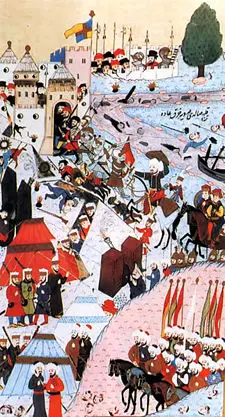
The Neolithic Starčevo and Vinča cultures existed in or near Belgrade about 7000 years ago. Settled in the fourth century B.C.E. by a Celtic tribe, the Scordisci, the city's first recorded name was Singidūn, before becoming the Roman settlement of Singidunum in the first century C.E. Roman Emperor Jovian (331-364), who re-established Christianity as the official religion of the Roman Empire, was born in Singidunum. In 395, the site passed to the Eastern Roman or Byzantine Empire. Across the Sava from Singidunum was the Celtic city of Taurunum (Zemun).
Slavs arrive
Singidunum was invaded by Huns, Sarmatians, Ostrogoths and Avars before the arrival of the Slavs around 630. The Frankish Kingdom destroyed the Avars in the ninth century. The Slavic name Beligrad appeared around 878, during the rule of the First Bulgarian Empire. The city remained a battleground between the Byzantine Empire, the Kingdom of Hungary, and the First Bulgarian Empire for about 400 years. The city hosted the armies of the First (launched 1096) and the Second Crusades (1147–1149). While passing through during the Third Crusade (1189–1192), Frederick Barbarossa saw Belgrade in ruins. Capital of the Kingdom of Syrmia since 1284, the first Serbian king to rule over Belgrade was Dragutin (died 1316), who received it as a gift from his father-in-law, the Hungarian king Stephen V.
Belgrade a haven
The Serbian Empire began to crumble after the Battle of Maritsa (1371), and the Battle of Kosovo (1389), as the Ottoman Empire conquered its southern territory. Belgrade flourished under despot Stefan Lazarević (1374-1427), who refortified the city's ancient walls, allowing the Despotate to resist the Ottomans for almost 70 years. The city became a haven for the many Balkan peoples fleeing from Ottoman rule, and is thought to have had a population of some 40,000–50,000.
In 1427, Stefan's successor Đurađ Branković had to return Belgrade to the Hungarians, and the Serbian capital was moved to Smederevo. During his reign, the Ottomans captured most of the Serbian Despotate, unsuccessfully besieging Belgrade first in 1440 and again in 1456. Over 100,000 Ottoman soldiers launched the famous Siege of Belgrade (July 4 to July 22, 1456), where the Christian army under John Hunyadi successfully defended the city, wounding the Sultan Mehmed II. This battle was regarded as "deciding the fate of Christendom."
Turkish conquest
Sultan Suleyman the Magnificent (1494-1566) and his 250,000 soldiers captured the fort on August 28, 1521, razed most of the city, and deported its Christian population to Istanbul. Belgrade was made an Ottoman Sanjak, attracting new inhabitants—Turks, Armenians, Greeks, Ragusan traders, and others – becoming the second largest Ottoman town in Europe with over 100,000 people. Turkish rule introduced Ottoman architecture and built many mosques.
In 1594, the Turks crushed a Serb rebellion. Albanian- born Grand vizier Sinan Pasha (1506-1596) is disdained by the Serbs for ordering, in 1595, that the relics of Saint Sava, the founder of the independent Serbian Orthodox Church in the twelfth century, be burned as a revenge for Serbs siding with the Habsburgs in the preceding border skirmishes. Further deportations to Istanbul followed.
Austrian occupation
Habsburg Austria occupied Belgrade three times (1688–1690, 1717–1739, 1789–1791), but the Ottomans recaptured and razed the city each time. This was the period of the two Great Serbian Migrations, in which hundreds of thousands of Serbs, led by their patriarchs, retreated together with the Austrians into the Habsburg Empire, settling in today's Vojvodina and Slavonia.
Serbian uprisings
During the First Serbian Uprising, the Serbian revolutionaries held the city from January 8, 1806, until 1813, when the Ottomans retook the city. After the Second Serbian Uprising in 1817, Serbia reached semi-independence, which the Ottoman Porte recognized in 1830. When Serbia reached full independence in 1878, and became the Kingdom of Serbia in 1882, Belgrade became a key city, but Serbia remained overwhelmingly agrarian and poor. In 1900, the capital had only 69,100 inhabitants, by 1905 the population had grown to more than 80,000, and by the outbreak of World War I in 1914, it had surpassed the 100,000 citizens.
World War I
Gavrilo Princip's assassination of Archduke Franz Ferdinand of Austria and his wife Sophie, Duchess of Hohenberg, in Sarajevo on June 28, 1914, triggered World War I. The Austro-Hungarian Army took Belgrade on November 30, 1914, but Serbian troops took the city on December 15. Belgrade fell to German and Austro-Hungarian troops on October 9, 1915. The city was liberated by Serbian and French troops on November 5, 1918.
After the war, Belgrade became the capital of the new Kingdom of Serbs, Croats and Slovenes, renamed the Kingdom of Yugoslavia in 1929. The kingdom was split into banovinas, and Belgrade, together with Zemun and Pančevo, formed a separate administrative unit. Belgrade's population grew to 239,000 by 1931 (incorporating the town of Zemun, formerly in Austria-Hungary), and 320,000 by 1940. In 1927, Belgrade's first airport opened, and in 1929, its first radio station began broadcasting. The Pančevo Bridge across the Danube was opened in 1935.
World War II
On March 25, 1941, the government of regent Crown Prince Paul signed the Tripartite Pact with the Axis powers to avoid war. This sparked mass protests in Belgrade and a military coup d'état led by Air Force commander General Dušan Simović, who proclaimed King Peter II to be of age to rule the realm. The German Luftwaffe bombed the city on April 6, 1941, and up to 17,000 citizens were killed. German, Italian, Hungarian, and Bulgarian forces invaded Yugoslavia. Belgrade's eastern suburbs were incorporated into a Nazi puppet state, the Independent State of Croatia, while Belgrade became the seat of another puppet government, headed by General Milan Nedić.
During the summer and fall of 1941, in reprisal for guerrilla attacks, Germans carried out several massacres of Belgrade citizens; in particular, members of the Jewish community were subject to mass shootings. General Franz Böhme, the German Military Governor of Serbia, rigorously enforced the rule that for every German killed, 100 Serbs or Jews would be shot.
The Allies bombed Belgrade on April 16, 1944, killing 1600 people. Communist Yugoslav Partisans and the Red Army liberated the city on October 20, 1944. On November 29, 1945, Marshal Josip Broz Tito proclaimed the Federal People's Republic of Yugoslavia in Belgrade (later to be renamed to Socialist Federal Republic of Yugoslavia on April 7, 1963).
Belgrade grows
During the post-war period, Belgrade developed as an industrial center. The city's first television station began broadcasting in 1958. In 1961, the conference of Non-Aligned Countries was held in Belgrade under Tito's chairmanship. In 1968, student protests against Tito led to street clashes between students and the police. In March 1972, Belgrade was at the center of the last outbreak of smallpox in Europe.
After communism
On March 9, 1991, Vuk Drašković led 150,000 people in protest against Serbian president Slobodan Milošević (1941-2006). Two people were killed, 203 injured and 108 arrested. Tanks were deployed to restore order. Further protests were held from November 1996 to February 1997 after alleged electoral fraud at local elections, bringing Zoran Đinđić to power, the first non-communist mayor of Belgrade since World War II. NATO bombing during the Kosovo War in 1999 caused substantial damage to Belgrade. After the elections in 2000, street protests by over 800,000 people resulted in the ousting of Milošević, on October 5, 2000.
Government
Serbia is a parliamentary representative democratic republic. The chief of state is the president, elected for a five-year term, and the prime minister is the head of government, and of a multi-party system. The unicameral Serbian national assembly, which has 250 members, elects the prime minister. The part of Serbia that is neither in Kosovo nor in Vojvodina, often called "Serbia proper," is divided into 29 districts plus the City of Belgrade.
As a separate territorial unit, Belgrade has an autonomous city government. The Civic Assembly of Belgrade has 110 councilors who are elected for four-year terms. The 2008 majority parties are the same as in the Parliament of Serbia. The city is divided into 17 municipalities, 10 with "urban" status, and seven with "suburban" status. While each has its own local council, the suburban municipalities have slightly expanded powers, regarding construction, town planning and public utilities.
Most municipalities are on the southern side of the Danube and Sava rivers, in the Šumadija region. Zemun, Novi Beograd, and Surčin are on the northern bank of the Sava, and Palilula, spanning the Danube, is in both the Šumadija and Banat regions.
Economy
Belgrade is the most economically developed part of Serbia. The rocky transition from the former Yugoslavia to the Federal Republic during the early 1990s left Belgrade, like the rest of the country, harmed by an international trade embargo and hyperinflation. Yugoslavia overcame the problems of inflation in the mid-1990s. By 2008, over 30 percent of Serbia's GDP was generated by the city, which also has over 30 percent of Serbia's employed population. In terms of GDP per capita, Belgrade holds the region's top position, with a figure of $US18,204 in terms of purchasing power parity.
Many notable companies are based in Belgrade, including Jat Airways, Telekom Srbija, Telenor Serbia, Delta Holding, regional centers for Société Générale, Intel,Motorola, Kraft Foods, Carlsberg, Microsoft, Zepter, Japan Tobacco and many others.
Belgrade is a media hub. The city hosts the headquarters of the national broadcaster Radio Television Serbia - RTS, the RTS record label is based there, as is commercial broadcaster RTV Pink. High-circulation daily newspapers published in Belgrade include Politika, Blic, Večernje novosti, Glas javnosti, Press and Sportski žurnal.
Belgrade has an extensive public transport system based on buses (118 urban lines and more than 300 suburban lines), trams (12 lines), and trolleybuses (eight lines). Belgrade has a commuter rail network, Beovoz. Travel by coach is popular. The motorway system provides for easy access to Novi Sad and Budapest in the north; Niš to the south; and Zagreb, to the west.
Belgrade has numerous bridges—the two main ones being Branko's bridge and Gazela, both of which connect the core of the city to Novi Beograd (New Belgrade).
The Port of Belgrade is on the Danube. The city is also served by Belgrade Nikola Tesla Airport, 12km west of the city center. At its peak in 1986, nearly three million passengers traveled through the airport, though that number dwindled to a trickle in the 1990s. In 2007, 2.5 million passengers passed through.
Traffic congestion has become a problem. This was expected to be alleviated by the construction of a bypass, an "inner magistral semi-ring," and new bridges across the Sava and Danube rivers.
Demographics
Belgrade had 1,531,741 eligible voters in December 2007, according to the city's Institute for Informatics and Statistics. The number of registered voters nearly exceeded the entire population of the city six years earlier.
Belgrade has attracted people of varied ethnicity, who went there seeking a better life, or who fled as refugees from war and ethnic cleansing. The main ethnic groups are Serbs (1,203,045), Montenegrins (25,000), Roma (19,000), Croats (7000), Macedonians (8372), and Muslims by nationality (4617). Belgrade is home to up to 20,000 Chinese, who began moving there in the mid-1990s. Blok 70 in New Belgrade is known locally as the Chinese quarter.
Many Middle Easterners, mainly from Syria, Iran, Jordan and Iraq, arrived to study during the 1970s and 1980s, and have remained. Afghani and Iraqi Kurdish refugees are among some of the recent arrivals from the Middle East.
The Serbian language is the official language. Other languages include Romanian, Hungarian, Slovak, Ukrainian, and Croatian. Many are able to communicate in English as well, though somewhat limitedly.
The Serbian Orthodox community is by far the largest, with 1,429,170 adherents. There are 20,366 Muslims, 16,305 Roman Catholics, and 3796 Protestants. There was once a significant Jewish community, but following the Nazi occupation, and many Jews' subsequent emigration to Israel, their numbers have fallen to a mere 515 (2008).
Belgrade has two state universities and several private institutions for higher education. The "Great School," founded in Belgrade in 1808, was the earliest location of higher education in Serbia. The Lyceum followed in 1841, when it was moved from Kragujevac. By 1905, it had evolved into the University of Belgrade, which has more than 70,000 students.
Places of Interest
The historic areas and buildings of Belgrade are among the city's premier attractions. Belgrade has wildly varying architecture, from the center of Zemun, typical of a Central European town, to the more modern architecture and spacious layout of New Belgrade. The oldest buildings date only from nineteenth century, due to frequent wars and destruction. The oldest public structure in Belgrade is a nondescript Turkish turbe, while the oldest house is a modest clay house on Dorćol, from late eighteenth century. Of interest are:
- Skadarlija, located in the municipality of Stari Grad (Old town), and considered the main bohemian quarter of Belgrade. More traditional Serbian nightlife may be experienced there, accompanied by traditional music known as Starogradska. Skadar Street (the center of Skadarlija) and the surrounding neighborhood are lined with some of Belgrade's best and oldest traditional restaurants (called kafanas in Serbian). The neighborhood has Belgrade's oldest brewery, founded in the first half of the nineteenth century.
- The National Museum, founded in 1844, houses a collection of more than 400,000 exhibits,(over 5600 paintings and 8400 drawings and prints) including many foreign masterpieces and the famous Miroslavljevo Jevanđelje (Miroslav's Gospel).
- The Military Museum, which houses a wide range of more than 25,000 military exhibits dating as far back as to the Roman period, as well as parts of a F-117 stealth aircraft shot down by Yugoslav forces.
- Zemun, which is considered by the local population as a separate, and more cultural city than Belgrade. Belgraders consider Zemun an outer, Austro-Hungarian suburb of Belgrade.
- Nikola Pašić Square, is one of the central town squares, is named after Nikola Pašić who served as mayor of Belgrade, prime minister of Serbia and prime minister of Yugoslavia.
- The Kalemegdan Fortress, is the core and the oldest section of the urban area of Belgrade and for centuries the city population was concentrated only within the walls of the fortress.
- Knez Mihailova St, the favorite strolling avenue of the city.
- The Temple of Saint Sava is the largest Orthodox church in use in Belgrade.
- The Yugoslav Film Archive, with around 95,000 copies of films, is among the 10 largest archives in the world.
The city was one of the main centers of the Yugoslav New Wave music in the 1980s. There are numerous theaters, the most prominent of which are National Theatre, Theatre on Terazije, Yugoslav Drama Theatre, Zvezdara Theatre, and Atelier 212. Belgrade's two opera houses are: National Theatre and Madlenijanum Opera House. After Serbia's Marija Šerifović won the Eurovision Song Contest in 2007, Belgrade hosted the Eurovision Song Contest 2008.
There are numerous parks, monuments, cafés, restaurants and shops. Belgrade hosts the Belgrade Film Festival, Theatre Festival, Summer Festival, Music Festival, Book Fair, and the Belgrade Beer Festival. There are approximately a thousand sports facilities in the city.
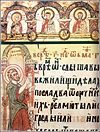 Miroslav's Gospel, twelfth century manuscript entered the UNESCO's Memory of the World Programme in 2005 |
Looking to the Future
Since its original settlement as the Roman city known as Singidunum, Belgrade has arisen (according to legend and verified history) from its ashes 38 times. Located at the convergence of three historically important routes between Europe and the Balkans—east-west along the Danube River valley from Vienna to the Black Sea; westward along the valley of the Sava River toward Trieste and northern Italy; and southeast along the valleys of the Morava and Vardar rivers to the Aegean Sea—has given it a history of possession by various foreign powers. Its location has enabled it to play an important role in several junctures in history.
The Balkan Peninsula, on which Belgrade lies, is a mélange of cultures and ethnicities. The virulent animosity among different groups has led to civil war, and to the area's nickname as the "Balkan tinderbox." Belgrade, emerging from an era of war and repression is, in the early twenty-first century, a work in progress. Its history has shaped it, yet it is up to its leaders and contributing citizens to determine its future.
While the city, along with the entire nation, suffered from corruption and abuse of power during the Miloševic-era, since that time its leaders have focused their efforts on the stabilization of the economic and social services systems. The government has committed itself to pursue socially accountable policy in an attempt to avoid social stratification of the population which has occurred in some former socialist countries during their periods of transition.
The City of Belgrade has received various domestic and international honors, including the French Légion d'honneur in 1920, the Czechoslovak War Cross, the Serbian Karađorđe's Star with Swords and the former Yugoslavian Order of the National Hero (proclaimed on October 20 1974, the anniversary of the overthrow of Nazi German occupation during World War II).[5]
In the competition for European cities and regions of the future in 2006 and 2007, organized by the Financial Times magazine, Belgrade was proclaimed “City of the Future in Southern Europe” in March 2006 in Cannes. Apart from Belgrade, awards also went to Paris as the “City of the Future in Western Europe,” Brno as the “City of the Future in Central Europe,” Baku as the “City of the Future in Eastern Europe” and London as the “City of the future in Northern Europe,” which was also named “European City of the Future 2006/07.” [6]
The country is in the process of negotiating the Stabilization and Association Agreement with the European Union, and is the world’s leading reformer as stated by the World Bank. In addition, the pace of structural reforms is ahead of that in other transition countries according to the European Bank for Reconstruction and Development.
As a leading educational center comprising 62 university-level institutions, Belgrade boasts a well-educated, fast learning, multilingual and IT literate labor force. Over 8,000 students graduate from Belgrade University every year, with one-third of them adding to the traditionally strong engineer base. According to Gallup International, the city's percentage of English speakers is the highest in Central and Eastern Europe, and an increasing number of western business schools open their affiliates in Belgrade.
These statistics show Belgrade's determination to join the ranks of progressive European cities. A critical issue will be its capacity to reconcile the major ethnic factions that define its current identity.
Notes
- ↑ Ancient Period. City of Belgrade. Retrieved March 16, 2012.
- ↑ Territory. City of Belgrade. Retrieved March 16, 2012.
- ↑ Geographical position. City of Belgrade. Retrieved March 16, 2012.
- ↑ 2011-11-15, PRVI REZULTATI, Konferencija za novinare, Statistical Office of the Republic of Serbia Retrieved March 16, 2012.
- ↑ City of Belgrade. Received Decorations Retrieved August 12, 2008.
- ↑ The Financial Times Limited. February 06, 2006. European Cities of the Future 2006/07 Retrieved August 12, 2008.
ReferencesISBN links support NWE through referral fees
- City of Belgrade. Belgrade Retrieved August 26, 2019.
- Lebl, Ženi. Until "the final solution": the Jews in Belgrade 1521-1942. Bergenfield, NJ: Avotaynu, 2007. ISBN 978-1886223332
- Levinsohn, Florence Hamlish. Belgrade: among the Serbs. Chicago: I.R. Dee, 1994. ISBN 978-1566630610
- Norris, David A. Belgrade: a cultural history. Oxford: Oxford University Press, 2008. ISBN 0195376099
- Pavić, Milorad. A short history of Belgrade. Belgrade: Prosveta, 1990. ISBN 978-8607005390
- Tešanović, Jasmina. The diary of a political idiot: normal life in Belgrade. San Francisco: Midnight Editions, 2000. ISBN 978-1573441148
Credits
New World Encyclopedia writers and editors rewrote and completed the Wikipedia article in accordance with New World Encyclopedia standards. This article abides by terms of the Creative Commons CC-by-sa 3.0 License (CC-by-sa), which may be used and disseminated with proper attribution. Credit is due under the terms of this license that can reference both the New World Encyclopedia contributors and the selfless volunteer contributors of the Wikimedia Foundation. To cite this article click here for a list of acceptable citing formats.The history of earlier contributions by wikipedians is accessible to researchers here:
The history of this article since it was imported to New World Encyclopedia:
Note: Some restrictions may apply to use of individual images which are separately licensed.
